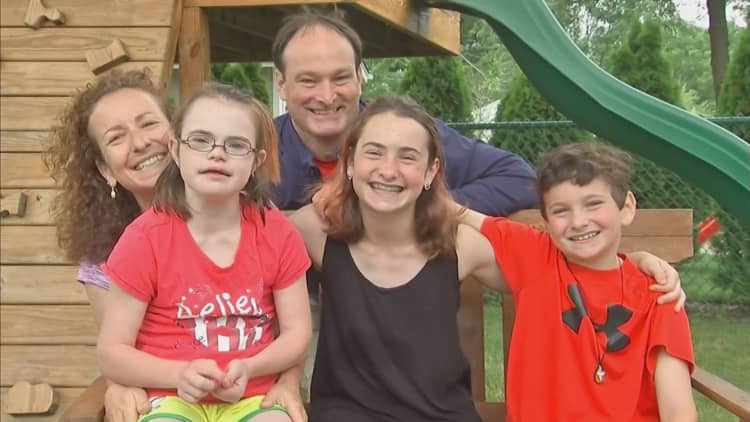
When asked to name her biggest financial challenge, Randi Gillespie doesn't hesitate.
"I have three kids," said the 47-year-old who lives with her husband, Tom, and children in a Chicago suburb.
Between soccer, softball, field hockey and covering monthly expenses, saving for the future is difficult. It's especially important for this family, since middle child Maddy has Down syndrome, and will require extra financial help throughout adulthood.
"It's as if they're planning for three retirements, the retirement for both parents as well as the retirement of the child with special needs," said family friend and financial advisor Mike Walther, president of Oak Wealth Advisors, in Deerfield Illinois. "That retirement often starts in their 20s and can last for 60 or more years."
That's why the Gillespies are looking forward to taking advantage of a new savings tool that's just becoming available to families with special-needs members.
It's as if they're planning for three retirements, the retirement for both parents as well as the retirement of the child with special needs.Mike Waltherpresident, Oak Wealth Advisors
After more than a decade of lobbying by families and advocates, Congress passed the "Stephen Beck Jr., Achieving a Better Life Experience Act" in December 2014. More commonly known as ABLE accounts, the program is modeled after the popular 529 college savings accounts, and it is administered by individual states.
To qualify, an individual must have been diagnosed with a qualifying disability by age 26. For this year, families can contribute up to $14,000 in post-tax dollars into the account. The principal and any gains can be withdrawn tax-free for qualifying expenses.
Walther says the tax-free component gives ABLE accounts a huge advantage over a special-needs trust, where accumulated income is subject to tax rates as high as 39 percent.
"Having a simpler account that is easily funded and easy to open such as an ABLE account will benefit Maddy in the future and provide for her future needs," said Gillespie.
Families can use the money for a wide range of expenses, including transportation, housing, vocational training and medical costs.
"We wanted to make sure funds in the accounts can be used for as many things as possible," said Chris Rodriguez, senior public policy advisor for the National Disability Institute, which runs the ABLE National Resource Center. The organization provides information about the program.
Another key advantage is the ability for a special needs individual to hold significant assets in their name and not lose their eligibility for government programs.
Many people with disabilities are enrolled in Medicaid or receive Supplemental Security Income, the latter of which has a limit of just $2,000. However, with ABLE accounts, families can save up to $100,000 and not affect the person's eligibility to continue receiving their full benefits.
Having a simpler account that is easily funded and easy to open such as an ABLE account will benefit Maddy in the future and provide for her future needs.Randi Gillespie
Many families like the Gillespies have been eagerly awaiting the rollout of these accounts. However, the process has been slow.
According to Rodriguez, 40 states have passed the legislation necessary to begin creating ABLE programs, but as of today only four — Ohio, Tennessee, Nebraska and Florida — are enrolling families. While most are expected to be national programs, some states, like Florida, will be available to in-state residents only.
To Randi Gillespie the benefits of this new financial tool is something worth waiting for.
"The more opportunities I can give her from a community, vocational, and from a financial standpoint, the better off she will be as an independent young woman who happens to have special needs," she said.
"On the Money" airs on CNBC Saturdays at 5:30 a.m. ET, or check listings for air times in local markets.




